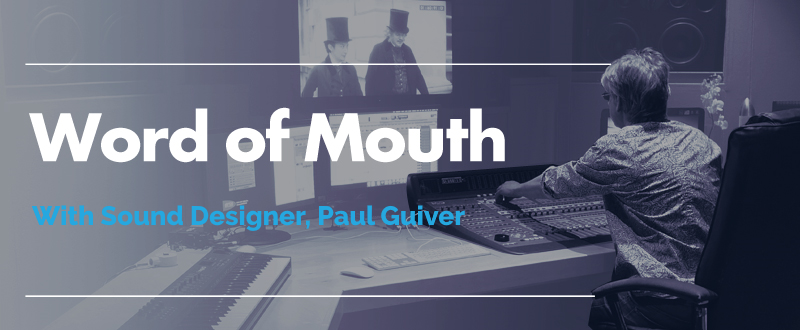
In this edition of Word of Mouth we talk to Sound Designer, Paul Guiver, about the rise of technology, the dark arts of the Foley Artist, and creating sound effects with coconuts.
How would you explain the role of the Sound Designer to a layman in one sentence?
Storytelling with sound: creating mood, light, shade and adding dynamics to the soundtrack.
What made you want to pursue a career in sound production, and what was your first job?
I was a musician in my teens and early twenties, this gave me experience of composing, recording and eventually making records. During this time, I was producing my own music and becoming more and more interested in the technical side. When I saw an advert in one of the national newspapers recruiting people for a television production course I jumped at the chance. I absolutely loved it; a perfect marriage of technical and creative skills and knew this was the direction for me.
My first job was working for Radio City in Liverpool as a Music Mixer / Engineer. It was a fantastic first job – recording both the shows and live performances.
What would you say is the biggest misconception about the world of sound design?
Ha! Probably the use of coconuts to create sound effects! Seriously, good sound design, ADR and foley is often transparent, people are only aware of the art if it is badly performed. It’s a backhanded compliment if a scene where the sound has been totally replaced goes un-noticed.
You’ve had a long and varied career, working on shows for all the major UK broadcasters. What has been your favourite project to work on, and why?
I have been very fortunate to have worked on many great shows. In the top 5 would be Art Attack for ITV – I was involved with the pilot in 1990 and seventeen years later the final show. There was a great sense of family with everyone that worked on the production. It’s often the people that make the experience memorable.
What’s the biggest challenge you’ve faced during your career?
Probably live news transmission for Euronews in Lyon, which was a bit scary at times, as all the direction was in French. Working and living in France was a great experience, being in situations out of your comfort zone is a good test of your character.
How has technology changed your role and your working methods over the years, and what advances do you see coming in the future?
The technology in sound post production has been life changing, as a freelance Dubbing Mixer/Sound Designer, it has given me the flexibility to work relatively seamlessly from studio to studio. The ability to receive and upload media via the internet means dubbing mixers can work remotely: producer approval or feedback can now be almost instantaneously received anywhere in the world.
As for the future, probably more developments in hook ups and shared media between studios. With companies like Netflix and Amazon, programme delivery will change to suit the size and format. It’s going be exciting, I know that!
Foley Artists are renowned for recreating sounds from unlikely objects. What’s the strangest thing you’ve used in the course of your work, and what’s the most difficult sound effect that you’ve had to recreate?
This is the dark art – many times the real sounds often don’t fit the pictures, so it might be the sound of two or three totally unrelated objects mixed together to create the right end result. It’s important to have a large props library and good surfaces to work on. I was involved with a recent animation project for Nickelodeon US called Zack & Quack, where the characters live in a pop-up book – all the SFX and foley had to be made from paper including explosions, crashes, trains, planes and automobiles, so it was quite a challenge.
What advice would you have for someone looking to start a career in sound production?
My advice is the advice I was given when I started my first TV job: “the job is 60% attitude and application and 40% talent: have the right approach and attitude, the rest will follow “. This has always served me well.
Paul Guiver is a Sound Designer & Dubbing Mixer, and a ProductionBase member. You can get in touch with him with via his PB Profile. If you’d like to be featured in a future Q&A, let us know!